Carlos of Mexico

 Handcarved Leather Wall Hangings
Click on thumbnail to enlarge
Yucatan, Mexico
Replicas of Ancient Maya, Aztec & other precolumbian peoples
dating back thousands of years. They reflect their culture, religeous
& ceremonial life.
"All of my wall hangings are really labor intensive. I
might spend a whole day working on a 5" x 5" section. I make exact
duplicates of artwork that was produced thousands of years ago. The
original artworks were made out of stone or paintings found in caves or
walls of ancient structures. First, I must trace them onto the leather.
Then I soak the leather in water. Then I use a very small knife and
cut the design onto the leather. Afterwards I use a variety of small
tools(I have over 255 of them) to stamp out the water along the lines that
I cut. Once the water is stamped out the shape will remain forever.
My pictures will last hundreds of years. After it dries, the coloring
of the picture is as labor intensive as the cutting/stamping. If
I spend 3 weeks cutting it will take almost the same amount of time to
dye them. Even the color is important. I use Maya indians to
help me pick out the colors if the original colors are too faded to see.
Every color has meaning to Maya & Aztec indians. My dyes are
made out of herbs and roots found in the Yucatan Jungle. (I live on the
outskirts of it) Sometimes I have to use acrylic.
Handcarved Leather Wall Hangings
Click on thumbnail to enlarge
Yucatan, Mexico
Replicas of Ancient Maya, Aztec & other precolumbian peoples
dating back thousands of years. They reflect their culture, religeous
& ceremonial life.
"All of my wall hangings are really labor intensive. I
might spend a whole day working on a 5" x 5" section. I make exact
duplicates of artwork that was produced thousands of years ago. The
original artworks were made out of stone or paintings found in caves or
walls of ancient structures. First, I must trace them onto the leather.
Then I soak the leather in water. Then I use a very small knife and
cut the design onto the leather. Afterwards I use a variety of small
tools(I have over 255 of them) to stamp out the water along the lines that
I cut. Once the water is stamped out the shape will remain forever.
My pictures will last hundreds of years. After it dries, the coloring
of the picture is as labor intensive as the cutting/stamping. If
I spend 3 weeks cutting it will take almost the same amount of time to
dye them. Even the color is important. I use Maya indians to
help me pick out the colors if the original colors are too faded to see.
Every color has meaning to Maya & Aztec indians. My dyes are
made out of herbs and roots found in the Yucatan Jungle. (I live on the
outskirts of it) Sometimes I have to use acrylic.
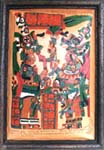 22" x 25 1/2"
Chel-Te - Great-skull, Zero, the brother of Chel-Te's mother.
Lintel 58 - Chel-Te appearing with his mother's brother in the period ending
rites on 9.16.5.0.0 (April 12, 756.)
22" x 25 1/2"
Chel-Te - Great-skull, Zero, the brother of Chel-Te's mother.
Lintel 58 - Chel-Te appearing with his mother's brother in the period ending
rites on 9.16.5.0.0 (April 12, 756.)
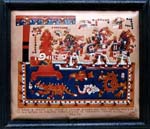 26" x 33 1/2"
Three warriors are sailing to this island. There are 3
small figures at the top. One is the symbol of "attack". One
is the symbol of "defend". Whenever you see those Maya symbols you
will see the symbol of "death". That's the third one. Swimming
in the water underneath the warriors are the animals. They are waiting
for the warrior to land on the island. They are going to attack and
eat them.
26" x 33 1/2"
Three warriors are sailing to this island. There are 3
small figures at the top. One is the symbol of "attack". One
is the symbol of "defend". Whenever you see those Maya symbols you
will see the symbol of "death". That's the third one. Swimming
in the water underneath the warriors are the animals. They are waiting
for the warrior to land on the island. They are going to attack and
eat them.
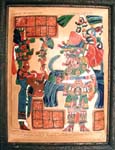 35" x 34"
Lady Eveningstar - Shield-Jaguar. Lintel 53: Shield-Jaguar
Dances with a K'awl scepter while his wife dances with a bundle - Yaxchilan,
Chiapas, Mexico.
35" x 34"
Lady Eveningstar - Shield-Jaguar. Lintel 53: Shield-Jaguar
Dances with a K'awl scepter while his wife dances with a bundle - Yaxchilan,
Chiapas, Mexico.
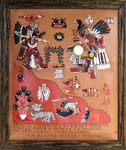 22" x 25"
Figura 14. Tezcatlipoca El Que Da y Quita La Riqueza.
Codice Borbonico, p.6. (detalle). Biblioteca Angel Palerm,
Ciesas
22" x 25"
Figura 14. Tezcatlipoca El Que Da y Quita La Riqueza.
Codice Borbonico, p.6. (detalle). Biblioteca Angel Palerm,
Ciesas
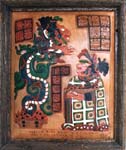 23" x 27 1/2"
Vision Rite by Lady 6-Tun on March 28, 755. Lintel 15
23" x 27 1/2"
Vision Rite by Lady 6-Tun on March 28, 755. Lintel 15
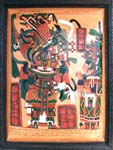 27 1/2" x 34 1/2"
Bird-Jaguar-Lady 6-sky -Ahau. Bird jaguar displays a bird
scepter while his wife holds a bundle forty days after he acceded as king.
Event on June 12, 752. Yaxchilan, Chiapas, Mexico
27 1/2" x 34 1/2"
Bird-Jaguar-Lady 6-sky -Ahau. Bird jaguar displays a bird
scepter while his wife holds a bundle forty days after he acceded as king.
Event on June 12, 752. Yaxchilan, Chiapas, Mexico
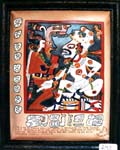 23" x 28"
The god of maize and life wears a necklace of jade beads and
a headdress with the maize symbol. The god of death and disease wears
copper bells and has spots on his body. Dresden Codex. Mexico
23" x 28"
The god of maize and life wears a necklace of jade beads and
a headdress with the maize symbol. The god of death and disease wears
copper bells and has spots on his body. Dresden Codex. Mexico
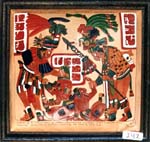 29 1/2" x 31"
(On the left) The canal, Kan-Toc, and his captive. (On
the right) Bird-Jaguar and his captive. Linel 8 in structure 1, from
Yaxchilan, Chiapas. Bird-Jaguar and Kan-Toc with their battle captives
on May 9, 755 A.D.
29 1/2" x 31"
(On the left) The canal, Kan-Toc, and his captive. (On
the right) Bird-Jaguar and his captive. Linel 8 in structure 1, from
Yaxchilan, Chiapas. Bird-Jaguar and Kan-Toc with their battle captives
on May 9, 755 A.D.
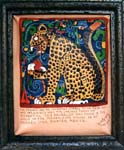 19 1/2" x 22 1/2"
The jaguar was an important symbol to the Maya and was frequently
used for various forms of decoration. This bas-relief was found in
the walls of the mausoleum mound 13 at Chichen Itza, Yucatan, Mexico
19 1/2" x 22 1/2"
The jaguar was an important symbol to the Maya and was frequently
used for various forms of decoration. This bas-relief was found in
the walls of the mausoleum mound 13 at Chichen Itza, Yucatan, Mexico
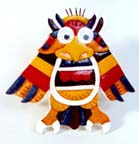

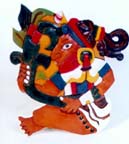
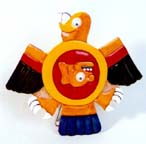
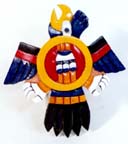
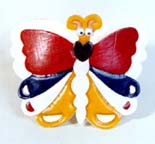 Barretts
More
of Carlos' Leatherwork
Artists list
Links
Barretts
More
of Carlos' Leatherwork
Artists list
Links
 If you have comments or suggestions, email me at apache511@yahoo.com
If you have comments or suggestions, email me at apache511@yahoo.com



















